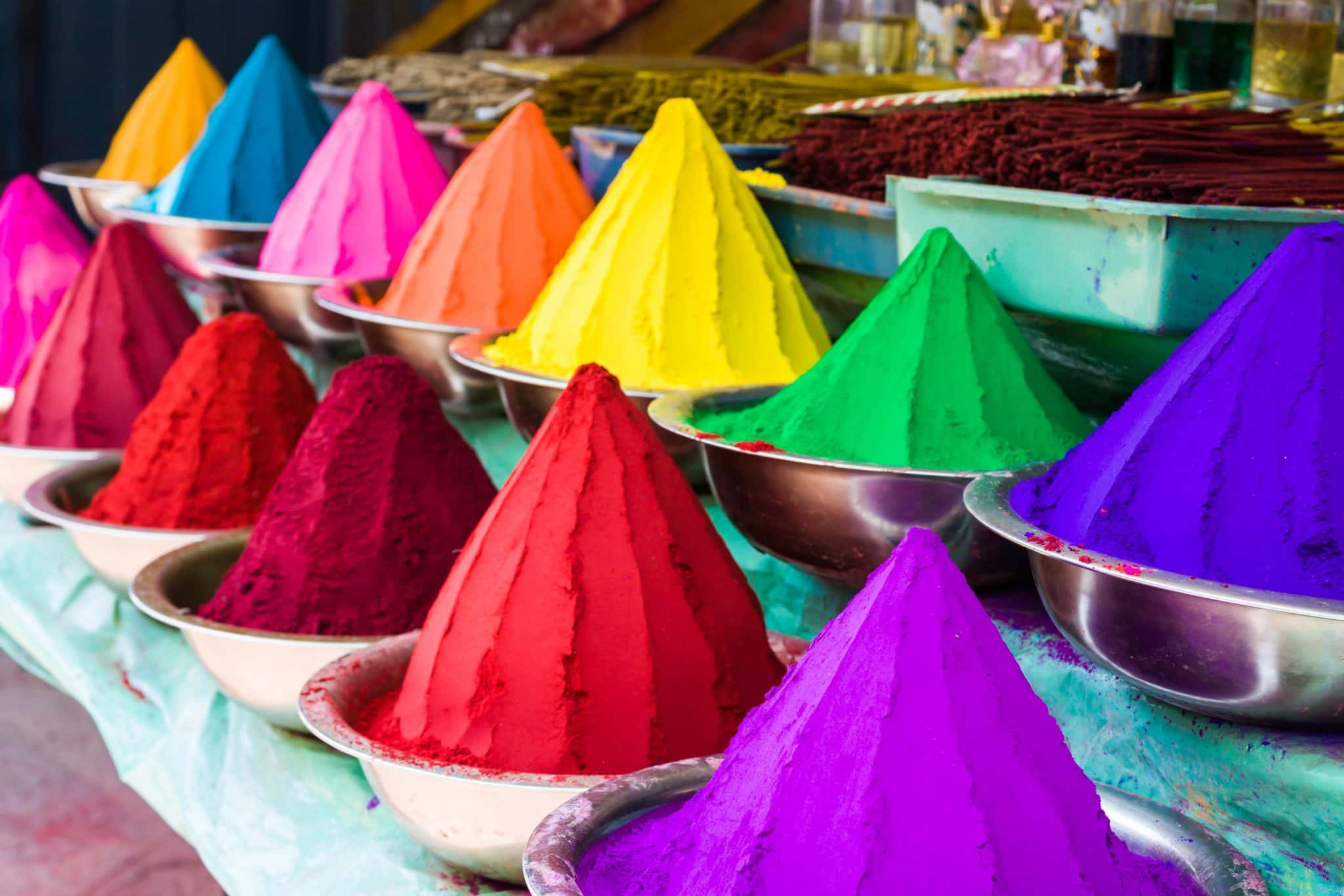Holi is just around the corner, and the air crackles with the anticipation of vibrant colours, infectious laughter, and joyful revelry. It’s a time for celebrations galore, when friends and family get together to splash gulal on each other, share delicious treats like gujiya and thandai, and create fun-filled memories that are sure to last a lifetime!
Adding to the festive spirit are beautiful rangolis, intricate floor art that adorns the entrances of homes. These vibrant creations, traditionally made with coloured powders, rice, and flowers, not only add a touch of beauty but also hold a deep cultural significance. From simple geometric patterns to elaborate depictions of deities and nature, there are many different types of rangolis, each with its own unique flair.
As you get ready for your Holi festivities, let’s explore some vibrant rangoli designs that will add a touch of tradition to your celebrations!
Significance of Rangoli Designs for Holi
A beautiful Indian tradition, creating rangolis is an art form passed down through generations. Called kolams in South India, these intricately crafted patterns are believed to be auspicious, and are drawn using coloured powders or rice paste on the floor in front of the house or in the pooja room. Rangoli designs are seen as an invitation to positive energy and good fortune to enter the household.
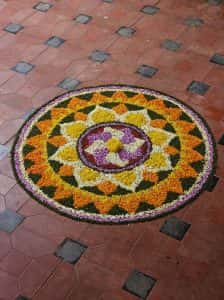 Especially during festive celebrations, rangolis hold a special significance, both as a way to welcome guests with gay decorations, and as a form of artistic expression. Rangolis also hold spiritual significance—devout Hindus believe that a rangoli at the doorstep will help to appease Goddess Lakshmi, allowing her to shower her blessings in the form of prosperity on their home!
Especially during festive celebrations, rangolis hold a special significance, both as a way to welcome guests with gay decorations, and as a form of artistic expression. Rangolis also hold spiritual significance—devout Hindus believe that a rangoli at the doorstep will help to appease Goddess Lakshmi, allowing her to shower her blessings in the form of prosperity on their home!
During Holi, the colours of this vibrant festival coalesce with the hues in the rangoli patterns, spreading happiness and sparking joy.
Rangoli Materials
What goes into the making of a rangoli design, and what are the materials you need to put it all together? From powders, to pastes and stencils, we bring you the lowdown, so that you can start creating your own designs!
Rangoli Powders and Pastes
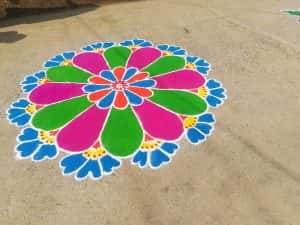 Traditionally, a rangoli would be drawn on the ground with rangoli powder, available in the brightest colours under the sun. Traditional colours include red, green, yellow, white, and black, but many other hues can be created using variants of the same. The finer the texture, the easier it is to smoothly apply it on the ground, and the more creative the patterns that can be made!
Traditionally, a rangoli would be drawn on the ground with rangoli powder, available in the brightest colours under the sun. Traditional colours include red, green, yellow, white, and black, but many other hues can be created using variants of the same. The finer the texture, the easier it is to smoothly apply it on the ground, and the more creative the patterns that can be made!
In South India, the heart of rangoli tradition, intricate designs come alive using a simple rice paste. This paste, made by grinding rice and water together, is a signature element. Skilled women traditionally created these rangolis by expertly letting the paste flow through their fingers, crafting mesmerizing patterns directly on the ground. Once dry, the rice paste designs take on a vibrant appearance, and hold their form until intentionally swept away, ready for a fresh rangoli the next day!
Sand Powder for Rangoli Designs
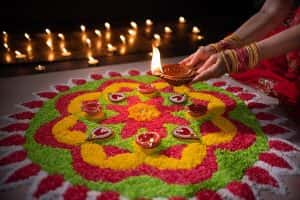 Coloured sand powder, or coloured rocks, are popular materials used to craft elaborate rangoli designs. Once the outline has been made—using chalk, rice flour, rangoli powder or paste—each of the segments is carefully and delicately filled with coloured sand powder.
Coloured sand powder, or coloured rocks, are popular materials used to craft elaborate rangoli designs. Once the outline has been made—using chalk, rice flour, rangoli powder or paste—each of the segments is carefully and delicately filled with coloured sand powder.
Some households like to colour rice grains in food-based hues and use that as a form of edible rangoli, which also serves the purpose of feeding birds and insects as an offering to the ‘Vasudaiva kutumbanam’ – where the world is considered as one family.
Flower Petals for Holi Rangolis
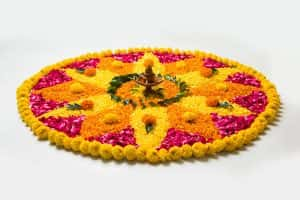 Floral rangolis are especially popular during Holi festivals, and bring a fragrant and vibrant element to the home decor. Commonly used flower petals include rose, marigold, and hibiscus, offering vibrant colours and cultural significance. This is an option that will tick the right boxes for sustainability enthusiasts, as flowers are biodegradable, completely natural and without any toxins!
Floral rangolis are especially popular during Holi festivals, and bring a fragrant and vibrant element to the home decor. Commonly used flower petals include rose, marigold, and hibiscus, offering vibrant colours and cultural significance. This is an option that will tick the right boxes for sustainability enthusiasts, as flowers are biodegradable, completely natural and without any toxins!
Rice Flour for Rangoli Design
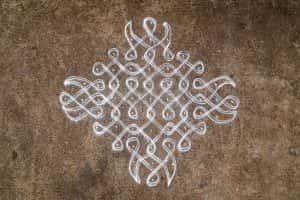 Often used to make wet rangoli paste, rice flour provides a smooth, mouldable base for intricate designs. It is mixed with chalk powder to increase the brightness and visibility on the ground, and can be easily swept away the next day. The Tamilian version of the rangoli uses patterns that are symmetrical and repetitive, and fashioned out of dots that are marked on a grid. Rice flour is readily available and highly affordable, making it the most popular choice for creating beautiful rangoli designs.
Often used to make wet rangoli paste, rice flour provides a smooth, mouldable base for intricate designs. It is mixed with chalk powder to increase the brightness and visibility on the ground, and can be easily swept away the next day. The Tamilian version of the rangoli uses patterns that are symmetrical and repetitive, and fashioned out of dots that are marked on a grid. Rice flour is readily available and highly affordable, making it the most popular choice for creating beautiful rangoli designs.
Rangoli Stencils
In today’s world, quick and easy methods are prized, and rangoli stencils are a very popular tool. These reusable templates offer guidance for creating intricate patterns, especially for beginners. The stencil, usually made of plastic or metal, is placed flat on the surface and allows powdered materials to be sprinkled through its design. Stencils come in various shapes and sizes, featuring traditional motifs or contemporary patterns.
Traditional Rangoli Designs for Holi
Traditional rangoli designs for Holi often incorporate vibrant colours like red, yellow, and green, reflecting the joyous spirit of festive celebrations. Popular motifs include flowers, footprints, and geometric patterns, symbolising good luck, prosperity, and the triumph of good over evil. Some traditional designs feature playful elements like water pots and pichkaris, or water guns. Peacock feathers are said to hold cultural significance and usher in good luck and prosperity.
Here are some of the most popular forms of traditional Holi rangoli designs:
Floral Rangoli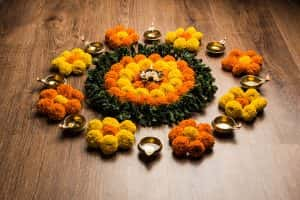
Holi is celebrated at the start of the spring season, when cities are awash with the fragrance of bright and colourful flowers in bloom. Floral rangolis are a popular choice for Holi, as they showcase the joy that the spring season brings. These flowers often hold symbolic meanings, such as lotus for purity and prosperity, and marigolds for happiness and new beginnings.
Geometric Rangoli
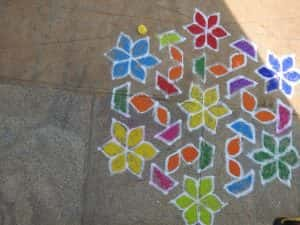 As the name indicates, geometric rangolis are drawn out using geometric shapes like squares, triangles and circles. They are typically repetitive and often drawn around a central axis. These designs are believed to bring good luck and prosperity, and the intricate patterns can be quite mesmerizing. They often hold symbolic meanings, representing elements like nature, the universe, or the sun.
As the name indicates, geometric rangolis are drawn out using geometric shapes like squares, triangles and circles. They are typically repetitive and often drawn around a central axis. These designs are believed to bring good luck and prosperity, and the intricate patterns can be quite mesmerizing. They often hold symbolic meanings, representing elements like nature, the universe, or the sun.
Alpana Rangoli
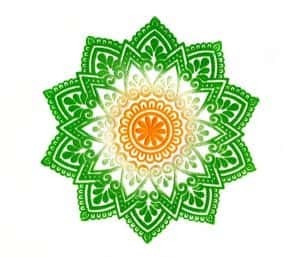 Alpana rangoli designs, popular in Bengal and parts of Odisha, are known for their intricate and detailed patterns. They often incorporate flowing lines, floral motifs, and various shapes like paisleys and mangoes. These designs are traditionally drawn using rice flour paste and are considered auspicious for welcoming prosperity and good luck.
Alpana rangoli designs, popular in Bengal and parts of Odisha, are known for their intricate and detailed patterns. They often incorporate flowing lines, floral motifs, and various shapes like paisleys and mangoes. These designs are traditionally drawn using rice flour paste and are considered auspicious for welcoming prosperity and good luck.
Dot Rangoli
Dot rangoli designs, also known as Kolams in South India, are created using rows of dots arranged in specific patterns. These dots are then connected to form various patterns and motifs, and can be quite elaborate and detailed. They often feature geometric shapes, floral motifs, and symbolic elements. The process of drawing dot rangolis is considered meditative and brings a sense of peace and focus. The art of drawing mandalas—a practice that brings in focus and concentration, and calms down the mind—has its roots in Indian kolams and dot rangoli designs.
Themed Rangoli
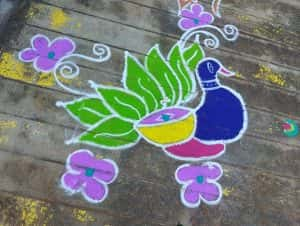 Themed rangoli designs incorporate specific themes or motifs related to the occasion or celebration. For Holi, these themes can include depictions of Lord Krishna and Radha, playing with colours, or celebratory objects like dhol drums and pichkaris (water guns).
Themed rangoli designs incorporate specific themes or motifs related to the occasion or celebration. For Holi, these themes can include depictions of Lord Krishna and Radha, playing with colours, or celebratory objects like dhol drums and pichkaris (water guns).
Fusion Rangoli
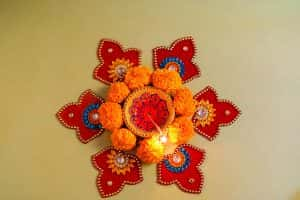 A fusion rangoli, as the name suggests, is a unique art form that blends traditional rangoli elements with modern aesthetics and materials. This creative approach pushes the boundaries of traditional art, creating the most stunning and innovative designs. There are no rules, and anything goes—so you’ll find a wider range of materials like coffee beans, pulses, seashells, tiny mirrors, and even recycled items like CDs or bottle caps forming part of the rangoli!
A fusion rangoli, as the name suggests, is a unique art form that blends traditional rangoli elements with modern aesthetics and materials. This creative approach pushes the boundaries of traditional art, creating the most stunning and innovative designs. There are no rules, and anything goes—so you’ll find a wider range of materials like coffee beans, pulses, seashells, tiny mirrors, and even recycled items like CDs or bottle caps forming part of the rangoli!
Happy Holi, From Our Family to Yours!
We hope we’ve given you all the information you need to start crafting the most exquisite rangoli designs this festive season. Sending you warm wishes for a Holi filled with the colours of love, laughter, and togetherness! May this festival paint your life with hues as bright and beautiful as the rangolis you create.
Happy Holi!
FAQs
1. Can I incorporate modern elements into traditional rangoli designs for Holi?
Yes, you can! There really are no rules, and Holi is all about having fun! You can incorporate modern elements into your traditional rangoli designs for Holi in many different ways:
- Materials: Experiment with non-traditional materials like coloured sand, glitter, coffee grounds, or even crushed flowers alongside the usual dry powders to create a fusion rangoli.
- Patterns: Break away from strictly geometric patterns and explore modern art styles, abstract shapes, or even pop culture references.
- Themes: Go beyond traditional themes of flowers and peacocks. Consider incorporating contemporary themes like music, nature, or even social messages written in words!
- 3D elements: You can also add a modern touch by creating a 3D effect using small pebbles, beads, marbles, or clay figurines within your design.
The sky’s the limit to your creativity, but do remember to respect the essence of celebrating Holi while you are at it!
2. How can I protect my rangoli designs from being disturbed during Holi celebrations?
Protecting your rangoli during Holi celebrations can be tricky, what with all the flying gulal and pichkari fights that are happening all around you! But here are some tips:
- Location: Choose a well-protected area like a doorway, a verandah, or a corner less likely to have people trampling all over.
- Materials: Use long-lasting materials like dry rice, pulses, or commercially available rangoli powders that are less likely to smudge. In South India, rice paste is used to make rangolis, and will last longer than a powder rangoli.
- Sealant: Apply a light coat of a clear, water-based sealant spray (available at most craft stores) after the rangoli is complete. This helps protect it from mild water splashes or accidental touches.
- Temporary fence: You could even create a temporary fence using low planters, decorative stones, or even colourful ribbons to prevent people from stepping on your painstakingly crafted rangoli design!
In the end, though, it’s all about having fun! And if your rangoli gets destroyed in the process, so be it!
3. Are there any tips for beginners who want to try making rangoli designs for the first time?
Rangoli art is fun and accessible for everyone, even beginners! Do remember:
- Start simple: Begin with basic geometric patterns like dots, lines, and squares. You can gradually progress to more intricate designs as you gain confidence. If you try working on an elaborate design before mastering the basics, you might find that you lose interest all too soon!
- Use stencils: Nowadays, pre-made rangoli stencils are available in many online stores. These are great for getting started and help to ensure symmetrical designs without too much effort.
- Practice on paper: Before transferring your rangoli design onto the floor, practice drawing it on paper first. This helps refine your skills and allows for mistakes without ruining the final product.
- Erase mistakes: If you do make a mistake, carefully wipe it away using a tissue paper or a damp cloth. Wait for the surface to dry before re-attempting the design in the same spot.
- Watch tutorials: Many online tutorials demonstrate rangoli creation step-by-step. This visual guidance can be extremely helpful for beginners.
4. What are some tips for selecting the right location to create a rangoli design for Holi?
Choosing the perfect location for your rangoli is crucial:
- Choose a spot that is easily visible, where your rangoli design can be appreciated by everyone!
- Ensure the surface is clean, dry, and swept free of any debris.
- Choose an area with enough space to comfortably accommodate your design size.
- Traditionally, rangoli designs are drawn near the entrance of the house or in the puja room, symbolising a welcoming gesture and good luck. Some people also like to draw border patterns on the walls of the puja room, and this is a good location as well.
5. Do I need special skills to create rangoli designs for Holi?
Of course not! Creating rangoli designs for Holi does not call for any special skills. All it takes is the interest to create something that’s beautiful, and the patience to carry it out with care. A rangoli is an art form that celebrates creativity and cultural expression. Anyone can participate, regardless of artistic ability (or the lack of it)! The most important thing is to have fun, express yourself, and embrace the spirit of Holi!

